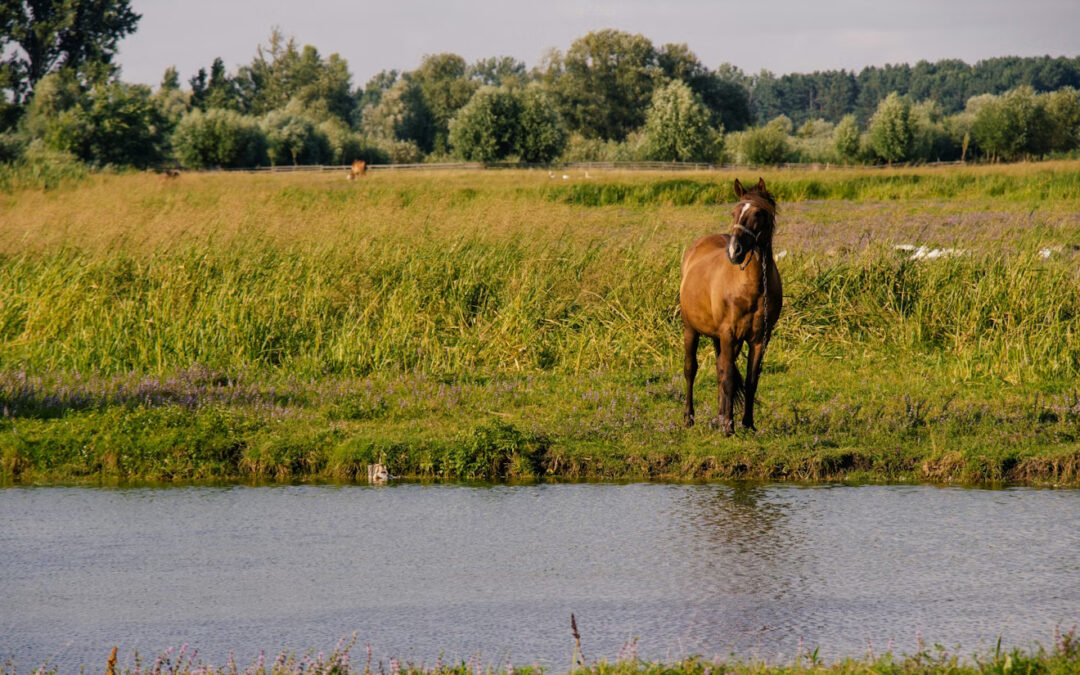Potomac horse fever (PHF) has made a significant comeback in recent years, catching many horse owners off guard. Once thought to be a regional issue when it was first discovered in 1979 near the Potomac River in the eastern United States, PHF is now appearing in various regions across the U.S. and Canada. As cases have re-emerged, horse owners need to be informed and proactive about this potentially serious disease. The best defense against PHF is prevention through vaccination, and we’re here to help you understand why it’s so important.
What is Potomac Horse Fever?
Potomac horse fever is a seasonal disease that primarily affects horses kept near rivers, streams, or irrigated pastures. PHF is caused by a bacterium that originates in aquatic environments, typically developing in flatworms found in snails. Horses become exposed by ingesting these aquatic insects or flukes, especially during late spring to early fall when the disease is most prevalent.
While PHF mainly affects horses, there have been rare cases reported in dogs and cats as well.
Recognizing the Signs of PHF
PHF can present in a variety of ways, but initial symptoms include:
- Depression and a sudden high fever
- Loss of appetite
- Colic
- Loose manure that can progress to profuse, watery diarrhea
- Swelling (edema) of the head, legs, and abdomen
- Laminitis, which can develop quickly
- In pregnant mares, PHF can cause late-term abortions
It’s important to note that symptoms can escalate rapidly within 7 to 10 days, making early detection and treatment extremely important.
Why Has PHF Re-Emerged?
PHF vaccination rates have dropped in recent years due to the disease being less common in certain areas. As a result, horses became more vulnerable when cases started to reappear. With many horses unvaccinated, the disease has been able to spread more easily, causing outbreaks in regions that had not seen PHF in a long time.
Prevention is Key: Vaccinate Your Horse
Vaccination remains the most effective way to protect your horse from PHF. While it’s possible for vaccinated horses to contract the disease, they typically experience a much milder form. This means quicker recovery times and a reduced risk of serious complications such as laminitis or abortion in pregnant mares.
In addition to vaccination, there are other steps you can take to reduce the risk of PHF:
- Minimize insect ingestion by turning off lights in the barn or stables at night, which attract insects that may carry the disease.
- Regularly clean water sources and feeders, especially in pastures near rivers or streams.
- Monitor your horse’s behavior and health, especially during peak PHF seasons.
Testing and Treatment
If you suspect that your horse may have contracted PHF, it’s important to act fast. Testing for PHF is available but can take longer than 7 to 10 days to get results, which is often the period when symptoms intensify. This is why early vaccination and preventive measures are so vital.
If your horse shows signs of PHF, contact us immediately to start treatment, as early intervention is imperative to achieve a positive outcome.
Stay Ahead of Potomac Horse Fever with Vaccination
Potomac horse fever can be serious, but with the right preventive measures, you can significantly reduce the risk to your horse. Vaccination is your best line of defense, and we highly recommend scheduling a vaccination appointment today, especially if you’re in an area where PHF has been reported. Protect your horse from PHF to ensure they stay healthy throughout the fall season.
If you have any questions or would like to schedule your horse’s PHF vaccination, please contact Tri-State Veterinary Services. We’re here to help keep your equine companions safe!
Ready to vaccinate or need more information? Call us at (860) 459-0986.
Stay informed, stay prepared, and let’s work together to keep your horses protected from Potomac horse fever.
Image credit: Photo by Viktor Smoliak on Unsplash

